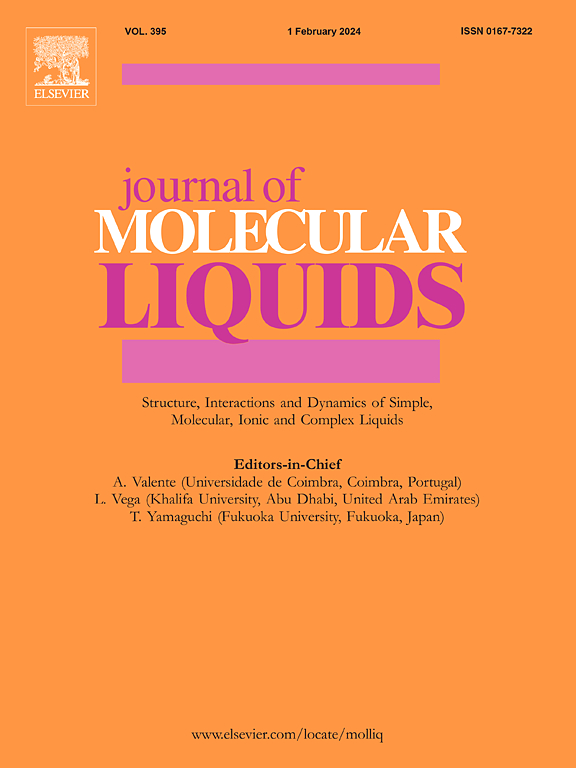Effect of imidazolium-based ionic liquid on CO2 sequestration: a study on solubility, interfacial properties, and X-ray imaging in water-wet formations
IF 5.3
2区 化学
Q2 CHEMISTRY, PHYSICAL
引用次数: 0
Abstract
The efficiency of geological CO₂ sequestration is often limited by low CO₂ solubility, which poses challenges for long-term storage stability. This study addresses these limitations by exploring the potential of 1-butyl-3-methylimidazolium bromide (BMIM-Br) to enhance CO₂ storage in water-wet subsurface formations. BMIM-Br was synthesized via a microwave-assisted method and the structure was confirmed using different spectroscopic methods including Fourier Transform Infrared Spectroscopy (FTIR), and Proton Nuclear Magnetic Resonance (1H NMR) analysis.
Under conditions of 3 MPa and 323.15 K, the solubility of CO₂ in a 5 wt% BMIM-Br solution was more than double the solubility in pure water. At 0.3 MPa, the interfacial tension (IFT) between CO₂ and the BMIM-Br solution decreased from 36.3 mN/m to 32.9 mN/m at 293.15 and 323.15 K, respectively compared to the pure water values 69.9 mN/m and 63.8 mN/m respectively at the same conditions. When CO2 was injected into a Bentheimer sandstone rock sample fully saturated with the aqueous phase. There was a significant increase in CO₂ saturation (SCO2), rising from 0.58 with pure water to 0.72 with BMIM-Br. The lowered interfacial tension allows more of the pore space to be accessed at the same imposed capillary pressure. When the aqueous phase was injected to displace CO2, the residual saturation was 0.21 with pure water, but only 0.16 for the BMIM-Br solution. This is likely a consequence of increased dissolution of CO2 in BMIM-Br. These results suggest that BMIM-Br significantly improves CO₂ solubility and injectivity by reducing interfacial tension. Its overall impact points to a promising strategy for optimizing CO₂ sequestration in subsurface formations.

咪唑基离子液体对CO2封存的影响:在水湿地层中的溶解度、界面性质和x射线成像研究
地质封存CO 2的效率往往受到CO 2溶解度低的限制,这对长期储存稳定性提出了挑战。本研究通过探索1-丁基-3-甲基咪唑溴(BMIM-Br)在水湿地下地层中增强CO₂储存的潜力来解决这些局限性。采用微波辅助法合成了bmi - br,并利用傅里叶变换红外光谱(FTIR)和质子核磁共振(1H NMR)等不同的光谱分析方法对其结构进行了证实。在3mpa和323.15 K条件下,CO₂在5wt % BMIM-Br溶液中的溶解度是在纯水中的溶解度的两倍以上。在0.3 MPa下,CO₂与BMIM-Br溶液的界面张力(IFT)在293.15 K和323.15 K时分别从36.3 mN/m和32.9 mN/m降至69.9 mN/m和63.8 mN/m。当二氧化碳被注入到一个水相完全饱和的Bentheimer砂岩样品中。CO₂饱和度(SCO2)显著增加,从纯水的0.58上升到bmic - br的0.72。降低的界面张力允许在相同施加的毛细压力下进入更多的孔隙空间。当注入水相取代CO2时,纯水的残余饱和度为0.21,而BMIM-Br溶液的残余饱和度仅为0.16。这可能是CO2在bmm - br中溶解增加的结果。这些结果表明BMIM-Br通过降低界面张力显著提高CO 2的溶解度和注入性。它的总体影响指向了优化地下地层CO 2封存的有希望的策略。
本文章由计算机程序翻译,如有差异,请以英文原文为准。
求助全文
约1分钟内获得全文
求助全文
来源期刊

Journal of Molecular Liquids
化学-物理:原子、分子和化学物理
CiteScore
10.30
自引率
16.70%
发文量
2597
审稿时长
78 days
期刊介绍:
The journal includes papers in the following areas:
– Simple organic liquids and mixtures
– Ionic liquids
– Surfactant solutions (including micelles and vesicles) and liquid interfaces
– Colloidal solutions and nanoparticles
– Thermotropic and lyotropic liquid crystals
– Ferrofluids
– Water, aqueous solutions and other hydrogen-bonded liquids
– Lubricants, polymer solutions and melts
– Molten metals and salts
– Phase transitions and critical phenomena in liquids and confined fluids
– Self assembly in complex liquids.– Biomolecules in solution
The emphasis is on the molecular (or microscopic) understanding of particular liquids or liquid systems, especially concerning structure, dynamics and intermolecular forces. The experimental techniques used may include:
– Conventional spectroscopy (mid-IR and far-IR, Raman, NMR, etc.)
– Non-linear optics and time resolved spectroscopy (psec, fsec, asec, ISRS, etc.)
– Light scattering (Rayleigh, Brillouin, PCS, etc.)
– Dielectric relaxation
– X-ray and neutron scattering and diffraction.
Experimental studies, computer simulations (MD or MC) and analytical theory will be considered for publication; papers just reporting experimental results that do not contribute to the understanding of the fundamentals of molecular and ionic liquids will not be accepted. Only papers of a non-routine nature and advancing the field will be considered for publication.
 求助内容:
求助内容: 应助结果提醒方式:
应助结果提醒方式:


